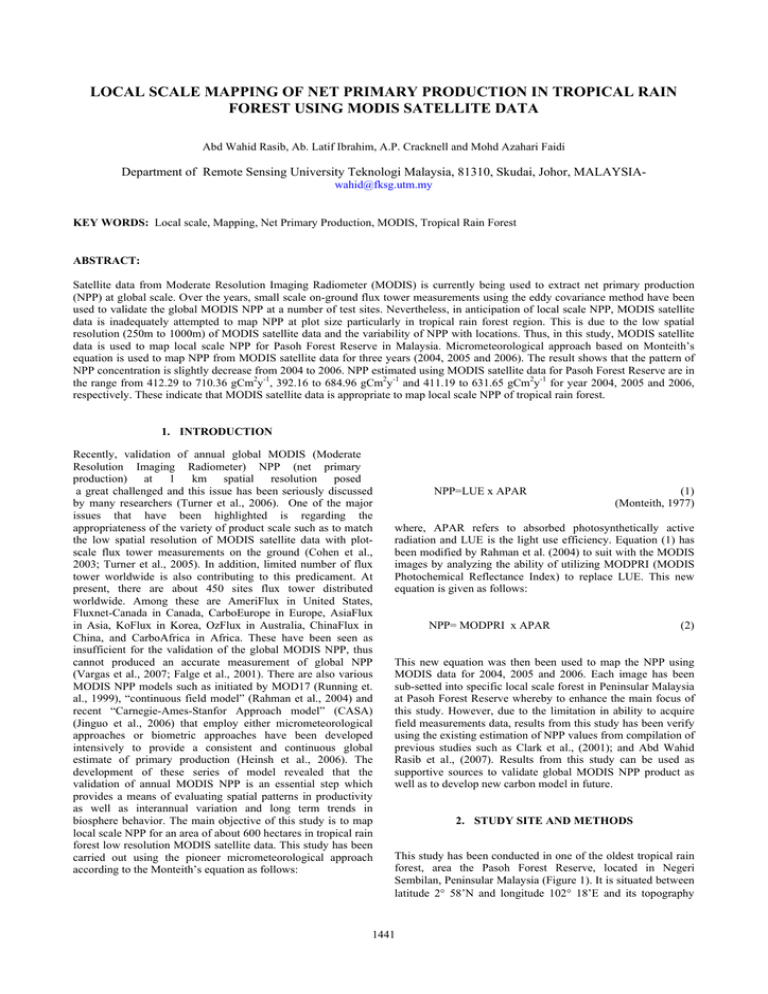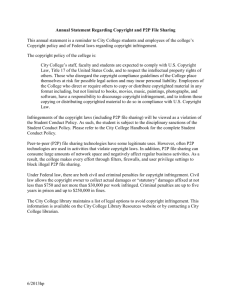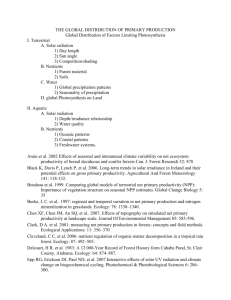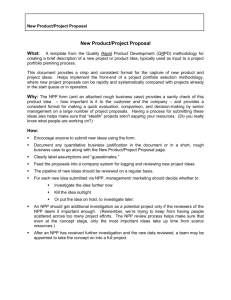LOCAL SCALE MAPPING OF NET PRIMARY PRODUCTION IN TROPICAL RAIN
advertisement

LOCAL SCALE MAPPING OF NET PRIMARY PRODUCTION IN TROPICAL RAIN FOREST USING MODIS SATELLITE DATA Abd Wahid Rasib, Ab. Latif Ibrahim, A.P. Cracknell and Mohd Azahari Faidi Department of Remote Sensing University Teknologi Malaysia, 81310, Skudai, Johor, MALAYSIAwahid@fksg.utm.my KEY WORDS: Local scale, Mapping, Net Primary Production, MODIS, Tropical Rain Forest ABSTRACT: Satellite data from Moderate Resolution Imaging Radiometer (MODIS) is currently being used to extract net primary production (NPP) at global scale. Over the years, small scale on-ground flux tower measurements using the eddy covariance method have been used to validate the global MODIS NPP at a number of test sites. Nevertheless, in anticipation of local scale NPP, MODIS satellite data is inadequately attempted to map NPP at plot size particularly in tropical rain forest region. This is due to the low spatial resolution (250m to 1000m) of MODIS satellite data and the variability of NPP with locations. Thus, in this study, MODIS satellite data is used to map local scale NPP for Pasoh Forest Reserve in Malaysia. Micrometeorological approach based on Monteith’s equation is used to map NPP from MODIS satellite data for three years (2004, 2005 and 2006). The result shows that the pattern of NPP concentration is slightly decrease from 2004 to 2006. NPP estimated using MODIS satellite data for Pasoh Forest Reserve are in the range from 412.29 to 710.36 gCm2y-1, 392.16 to 684.96 gCm2y-1 and 411.19 to 631.65 gCm2y-1 for year 2004, 2005 and 2006, respectively. These indicate that MODIS satellite data is appropriate to map local scale NPP of tropical rain forest. 1. INTRODUCTION Recently, validation of annual global MODIS (Moderate Resolution Imaging Radiometer) NPP (net primary production) at 1 km spatial resolution posed a great challenged and this issue has been seriously discussed by many researchers (Turner et al., 2006). One of the major issues that have been highlighted is regarding the appropriateness of the variety of product scale such as to match the low spatial resolution of MODIS satellite data with plotscale flux tower measurements on the ground (Cohen et al., 2003; Turner et al., 2005). In addition, limited number of flux tower worldwide is also contributing to this predicament. At present, there are about 450 sites flux tower distributed worldwide. Among these are AmeriFlux in United States, Fluxnet-Canada in Canada, CarboEurope in Europe, AsiaFlux in Asia, KoFlux in Korea, OzFlux in Australia, ChinaFlux in China, and CarboAfrica in Africa. These have been seen as insufficient for the validation of the global MODIS NPP, thus cannot produced an accurate measurement of global NPP (Vargas et al., 2007; Falge et al., 2001). There are also various MODIS NPP models such as initiated by MOD17 (Running et. al., 1999), “continuous field model” (Rahman et al., 2004) and recent “Carnegie-Ames-Stanfor Approach model” (CASA) (Jinguo et al., 2006) that employ either micrometeorological approaches or biometric approaches have been developed intensively to provide a consistent and continuous global estimate of primary production (Heinsh et al., 2006). The development of these series of model revealed that the validation of annual MODIS NPP is an essential step which provides a means of evaluating spatial patterns in productivity as well as interannual variation and long term trends in biosphere behavior. The main objective of this study is to map local scale NPP for an area of about 600 hectares in tropical rain forest low resolution MODIS satellite data. This study has been carried out using the pioneer micrometeorological approach according to the Monteith’s equation as follows: NPP=LUE x APAR (1) (Monteith, 1977) where, APAR refers to absorbed photosynthetically active radiation and LUE is the light use efficiency. Equation (1) has been modified by Rahman et al. (2004) to suit with the MODIS images by analyzing the ability of utilizing MODPRI (MODIS Photochemical Reflectance Index) to replace LUE. This new equation is given as follows: NPP= MODPRI x APAR (2) This new equation was then been used to map the NPP using MODIS data for 2004, 2005 and 2006. Each image has been sub-setted into specific local scale forest in Peninsular Malaysia at Pasoh Forest Reserve whereby to enhance the main focus of this study. However, due to the limitation in ability to acquire field measurements data, results from this study has been verify using the existing estimation of NPP values from compilation of previous studies such as Clark et al., (2001); and Abd Wahid Rasib et al., (2007). Results from this study can be used as supportive sources to validate global MODIS NPP product as well as to develop new carbon model in future. 2. STUDY SITE AND METHODS This study has been conducted in one of the oldest tropical rain forest, area the Pasoh Forest Reserve, located in Negeri Sembilan, Peninsular Malaysia (Figure 1). It is situated between latitude 2° 58’N and longitude 102° 18’E and its topography 1441 The International Archives of the Photogrammetry, Remote Sensing and Spatial Information Sciences. Vol. XXXVII. Part B7. Beijing 2008 lies between 75m to 150m above sea level (World Geodetic System 1984). The core area of about 600 hectare of Pasoh Forest Reserve is a primary lowland mixed dipterocarp forest (tropical evergreen broad-leaved forest) with terrain type is quoted as gentle hill slope. This forest reserve is surrounded by various species of tree such as Dipterocarpaceae, Leguminosae, and Burseraceae as well as Euphorbiaceae, and Annonaceae for dominant understory species. The continuous canopy height is approximately 35 m, although some emergent trees exceed 45 m. Pasoh Forest Reserve generally receives relatively high average annual rainfall of 1733mm (2003-2005). The highest rainfall normally occurs during the months of March to May and September to January. Meanwhile, the mean monthly temperature is in the ranges of 24.5°C to 27°C (2002-2005). This Forest Reserve contains three experimental plots that have been used extensively for studying primary productivity of tropical rainforest during International Biological Program (IBP) since 1978 (Kira 1978). Currently there are still some on-going joint research project between Forest Research Institute Malaysia (FRIM) and foreign research center (i.e. National Institute for Environmental Studies, Japan – NIES) which emphasize to the NPP study from remote sensing (Ab. Latif Ibrahim and Okuda, 2005). There are also some others related research been conducted using tower flux measurements and biomass measurements that provide useful information for this study (Abd Rahim Nik et al., 2005 and Abd. Rahman Kassim et al., 2005). Moreover, there are some sophisticated instruments that are currently located on the top of flux tower (52 meter height) which is located in about 6 hectares plot such as LI190 (LICOR, USA) for PAR and LUE observation, HMP45 (VAISALA, Finland) for air temperature recorded and RT-5 (Ikeda keiki, Japan) for precipitation observation (http://asiaflux.net). Furthermore, the biometric parameter such as DBH is well documented by FRIM from previous researches in these experimental plots. stress-induced reduction in NPP of terrestrial vegetation. This model known as simple “continuous field model” solely based on spectral data whereby significantly utilizing only the visible and near infrared bands (band 1: 620-670 nm and band 2: 841876 nm) as well as the “ocean” bands (band 11: 526-536 nm and band 12: 546-556 nm) to explain the variability of fluxtower based daily NPP. On the other hand, the most noteworthy is a spectral index called the “Photochemical Reflectance Index” (PRI) was determined and has been analyzed appropriately using tower-based LUE values. This satellitebased PRI has been proven for the ability to track the changes in landscape-level photosynthesis activity. The definition of the PRI is given by; PRI = (ρ 531 - ρ )/(ρ ref 531 +ρ ) (3) ref where, ρ represents reflectance at the wavelength (nm) expressed by the numeral subscripts, and ref represents a reference wavelength, typically 550 or 570 nm. Thus, the calculation of MODIS-derived PRI (or MODPRI) is given as; MODPRI = (ρ where ρ b11 and ρ b11 b12 -ρ b12 )/(ρ b11 +ρ ) 12 (4 ) represent band 11 and band 12, of MODIS data respectively. In addition, the calculation of the Normalized Difference Vegetation Index (NDVI) using band 1 and band 2 is given as; NDVI = (ρ - ρ ) / (ρ + ρ ) b2 b1 b2 b1 (5) Subsequently, the NDVI values are utilized to calculate the fraction of PAR (fPAR) absorbed by vegetation using the following equations; fPAR = 1.24 x NDVI – 0.168 Figure 1: Location of the study area For the purpose of this study, level 1B of Terra MODIS satellite data for Peninsular Malaysia has been acquired from http://ladsweb.nascom.nasa.gov. Three years of MODIS satellite data dated 2th October 2004, 10th October 2005 and 2th October 2006, respectively with minimum cloud cover have been selected using quick-look menu provided in this free download website. Each of the data has been geocoded to the Malaysian Rectified Skew Orthomorpic (MRSO) projection coordinate system. Model developed by Rahman et al. (2004) based on micrometeorological approach was employed to determine the local scale NPP from MODIS data in this study. Rahman et al. (2004) have revealed that their new model is capable to track the changing photosynthetic light use efficiency (LUE) and (6) Therefore, absorbed PAR (APAR) for each pixel can be calculated from the relationship: of APAR = fPAR x PAR. The PAR values is actually restricted to just a portion of electromagnetic spectrum from 0.4 to 0.7 micrometers (μm) which is comparable to the range of light the human eye can see. Therefore, this value is assumed to be approximately 0.5 of the incoming solar radiation (Prasad et al. 2002). Consequently, the model has revealed a linear relationship between NPP and the (MODPRI x APAR), which can explain 88% of the temporal variability in NPP. Finally in this model NPP can be estimated using the following regression equation; NPP = 0.5139 (MODPRI x APAR) – 1.9818 (7) This equation generates the value of NPP in units of g Cm2 y-1. 1442 The International Archives of the Photogrammetry, Remote Sensing and Spatial Information Sciences. Vol. XXXVII. Part B7. Beijing 2008 3. RESULTS AND DISCUSSION Three years of local scale NPP (2004, 2005 and 2006) for an area of 600 hectares or approximately 190 pixels of MODIS satellite data for Pasoh Forest Reserve have been produced in this study using micrometeorological approach. NDVI and NPP for the whole of Peninsular Malaysia have been extracted as well whereby to be used as a reference map in order to verify the final output of this study. However, only NPP map for 2004, 2005 and 2006, respectively (Figure 2 (a), (b) and (c)) will be used to determine the range of NPP concentration in Peninsular Malaysia. (a) (a) (b) (b) (c) (c) Figure 3: MODIS NDVI map for Pasoh Forest Reserve. (a) 2004; (b) 2005; (c) 2006. (a) Figure 2: MODIS NPP for Peninsular Malaysia (a) 2004; 2005; (c) 2006 (b) Two sets of NDVI and NPP maps for Pasoh Forest Reserve have been succesfully accomplished using composite of visible and near infrared MODIS satellite data. Figure 3 (a), 3(b) and3 (c) are the NDVI maps showing pattern of greeness level at Pasoh Forest Reserve. While, Figure 4 (a), 4 (b) and 4 (c) display the NPP maps and these are the final output of this study. All output in Figure 2, 3, and 4, can be further explained statistically as in Table 1. 1443 (b) The International Archives of the Photogrammetry, Remote Sensing and Spatial Information Sciences. Vol. XXXVII. Part B7. Beijing 2008 As an overall the values of NPP from three years MODIS images in this study are comparable to the others previous similar researches. Goetz et al., (2000) by using the series of satellite observation have determined that the global annual NPP is ranged from 0 to 1500 g m2 y-1 (7.5 t ha-1yr-1). Running et al., (2004) showed the range between 100 to 1500 g C m2 y1 for estimation global annual NPP using MODIS images. Study by Clark et al., (2001) have estimated that the NPP values in tropical rain forest base on biometric approach is between 170 to 2170 gCm2y-1. Previous study conducted by Abd. Wahid Rasib et al., (2007) estimated that the average value of NPP in 2004 for a smaller scale of Pasoh Forest Reserve was 633.85 gCm2 y-1. Thus, output from this study have showed very relevence range in order to present the concentration of NPP to the very dense Pasoh Forest Reserve with limited field data acquistion. (c) Figure 4: MODIS NPP map for Pasoh Forest Reserve. (a) 2004; (b)2005; (c) 2006. Area Year Peninsular Malaysia 2004 2005 2006 2004 2005 2006 Pasoh Forest Reserve NDVI Min. Max. -0.60 0.79 -0.31 0.75 -0.23 0.74 0.20 0.73 0.10 0.48 0.11 0.47 2 -1 NPP (gCm y ) Min. Max 39.69 740.99 141.98 719.51 202.52 673.66 412.29 710.36 392.16 684.94 411.19 631.65 Table 1: The range of NDVI and NPP for Peninsular Malaysia and Pasoh Forest Reserve. Three years NDVI and NPP maps in 2004, 2005 and 2006 for Pasoh Forest Reserve are within the range NDVI and NPP for Peninsular Malaysia. While, minimum values for NDVI and NPP in Peninsular Malaysia is slightly increased from 2004 to 2006. However, maximum values show decrement. This pattern has indicated that the range for minimum and maximum values in Peninsular Malaysia during these three years has reduced. The minimum values for NDVI and NPP in Pasoh Forest Reserve were fluctuated from 2004 to 2006 but the maximum values were decreased. In addition, histogram in Figure 5 indicated that the NPP concentration was frequently distributed in the range of 550 to 680 gCm2y-1 during these three years for Pasoh Forest Reserve. 4. CONCLUSION This study has shown the used of series low resolution MODIS images for estimation of NPP using micrometeorological approach at local scale about 600 hectares area. Three years of MODIS images for the month of October 2004, 2005 and 2006, have been used to determine the temporal distribution NPP in Pasoh Forest Reserve. The pattern of NPP concentration in Pasoh Forest Reserve seems to be decreased from 2004 to 2006. The NPP for Peninsular Malaysia also shows similar pattern. Model developed by Rahman et al. (2004) using MODIS ocean bands in 80-years old broadleaf deciduous forest in Southern Indiana (39_190N, 86_240W, 275 m above sea level) also called as “continuous field model” have been successfully applied to the very huge and old local scale tropical rain forest such as Pasoh Forest Reserve. This model is solely based on remotely sensed spectral data that could explain 88% of variability in flux-tower based daily NPP. Results from this study can be used to provide very useful basic information related to the forest productivity mapping in tropical rain forest as well as to improve estimating of the spatial and temporal NPP using current global-scale MOD17. REFERENCES Ab. Latif Ibrahim and Okuda, T., 2005. Mapping net primary productivity of Peninsular Malaysia forest using satellite data. Annual report of the NIES/FRIM/UPM joint reserch project on tropical ecology and biodiversity 2005. pp: 111-118 Abd Rahman Kassim, Azizi Ripin, Nur Supardi Md. Noor, Niiyama, K., Kajimoto, T. Matsuura, Y., and Yamashita, T., 2005. Allometric relationship between stem diameter, tree height, leaf, stem and root biomass in Pasoh Forest Reserve. Annual report of the NIES/FRIM/UPM joint reserch project on tropical ecology and biodiversity 2005. pp: 27-36 Abd Rahim Nik, Siti Aishah Shamsuddin, Ahmad Abdul Salam, Mohd Md Sahat, Takanashi, S., Tani, M., Kosugi, Y., Matsuo, N., Ohkubo, S., Fukui, Y., Nakanishi, R., Noguchi, S., and Okuda, T, 2005. Understanding the roles of tropical forest in climate change through the energy/H2O/CO2 exchange processes. Annual report of the NIES/FRIM/UPM joint reserch project on tropical ecology and biodiversity 2005. pp: 1-10 Figure 5: MODIS NPP distribution histograms for Pasoh Forest Reserve in 2004, 2005 and 2006, respectively. Abd Wahid Rasib, , Ab. Latif Ibrahim, , Mohd Azahari Fandi, and Wan Hazli Wan Kadir, 2007. Mapping Net Primary Production in Tropical Rain Forest Using MODIS Satellite 1444 The International Archives of the Photogrammetry, Remote Sensing and Spatial Information Sciences. Vol. XXXVII. Part B7. Beijing 2008 Data. In: The 28th Asian Conference on Remote Sensing 2007, 12-16 November 2007, PWTC, Kuala Lumpur, Malaysia. Science. Vol. 16, No.4/November. http://www.springerlink.com/content/t5h8607m5t575183/ Clark, A. D., Brown, S., Kicklighter, W. D., Chambers, Q. J. Thomlinson, R. J., Jian Ni and Holland A. E. 2001. Net primary production in tropical forests: An evaluation and synthesis of existing field data. Ecological Applications, 11(2). pp: 371-384. Kira T. 1978. Primary productivity of Pasoh forest. Malayan Nature Journal 30: pp:291-297 Cohen, W. B., Maiersperger, T. K., Yang, Z., Gower, S. T., Turner, D. P., Ritts, W. D., Berterretche, M. and Running, S. W., 2003. Comparisons ofland cover and LAI estimates derived from ETM+ and MODIS for four sites in North America: A quality assessment of 2000/2001 provisional MODIS products. Remote Sensing. Environment, Vol. 88, pp. 233–255. Monteith, J. L., 1977. Climate and the efficiency of crop production in Britain. Philisophical Transactions of the Royal Society of London, Series B, (281). pp: 277-294. Rahman, A. F., Cordova, D. V., Gamon, A. J., Schmid, P. H., and Sims, A. D. 2004. Potential of MODIS ocean bands for estimating CO2 flux from terrestrial vegetation: A novel Approach. Geophysical Research Letters. (31) L10503. Falge, E., D. Baldocchi, R. Olson, P. Anthoni, M. Aubinet, C. Bernhofer, G. Burba, G. Ceulemans, R. Clement, H. Dolman, A. Granier, P. Gross, T. Grunwald, D., Hollinger, N. O. Jensen, G. Katul, P. Keronen, A. Kowalski, C. T. Lai, B. E. Law, T. Meyers, J. Moncrieff, E. Moors, J. W. Munger, K. Pilegaard, U. Rannik, C., Rebmann, A. Suyker, J. Tenhunen, K. Tu, S. Verma, T. Vesala, K. Wilson, and S. Wofsy. 2001. Gap filling strategies for long term energy flux data sets. Agricultural and Forest Meteorology 107:71-77. Running W. S., Nemani, R., Heinsch, A. F, Maosheng Zhao, Reevee M, and hirofumi hashimoto 2004. A continuous satellite-derived Measure of global terrestrial primary production. BioScience. Vol. 54. (6) • Pp 547-560 Goetz, J. S., Prince, S. D., Small, J., Gleason, A. and Thawley M. M. 2000. Interannual variability of global terrestrial primary production: Results of a model driven with satellite observations. Journal of Geophysical Research. (105). pp: 20,077-20,091 Turner, D. P., Ritts, W. D., Zhao, M.,. Kurc, S. A., Dunn, A. L., Wofsy, S. C., Small, E. E.,and Running, S. W., 2006. Assessing Interannual Variation in MODIS-Based Estimates of Gross Primary Production. IEEE Transactions on Geoscience and Remote Sensing, Vol. 44, No. 7. Heinsh, F.A., M. Zhao, Running S.W., Kimball J.S., Nemani R.R., Davis K.J., Bolstad P.V, Cook B.D., Desai A.R., Ricciuto D.M., Law B.E., Oechel W.C., Kwon H., Luo H., Wofsy S.C., Dunn A.L., Munger J.W., Baldocchi D.D., Xu L., Hollinger D.Y., Richardson A.D., Stoy P.C., Siqueira M.B.S., Manson R.K., Burns S.P., and Flanagan L.B.. 2006. Evaluation of remote sensing based terrestrial productivity from MODIS using regional tower Eddy flux network observations. IEEE Transactions on Geoscience and Remote Sensing. 44: 19081925. Turner, D. P., Ritts, W. D., Cohen, W. B., Maeirsperger, T., Gower, S. T., Kirschbaum, A., Running, S. W. , Zhao, M., Wofsy, S. C., Dunn, A., Law, B. E., Campbell, J. L., Oechel, W., Kwon, H., Meyers, T. P., Small, E. E., Kurc, S. A., and Gamon, J. A., 2005. Site-level evaluation of satellite-based global terrestrial gross primary production and net primary productionmonitoring. Global Change Biology., vol. 11, pp. 666–684 Jinguo, Y., , Niu, Z., and Wang, C., 2006. Vegetation NPP distribution based on MODIS data and CASA model—A case study of northern Hebei Province. Earth and Environmental Running, W. S., Nemani, R., Glassy, M. J., and Thornton, E. P., 1999. MODIS Daily Photosynthesis (psn) and Annual Net Primary Production (npp) product (MOD17) Algorithm Theoretical Basis Document. Version 3.0. 29 April Vargas, R., Cook, R., Agarwal, D., Boden, T., Papale, D. Van Ingen, C., Yang, B., Baldocchi, D., 2007. The Future of the Worldwide Flux Tower Databases. FLUXNET Workshop. Oak Ridge National Laboratory. Oak Ridge, TN, USA. October 2324. 1445 The International Archives of the Photogrammetry, Remote Sensing and Spatial Information Sciences. Vol. XXXVII. Part B7. Beijing 2008 1446



